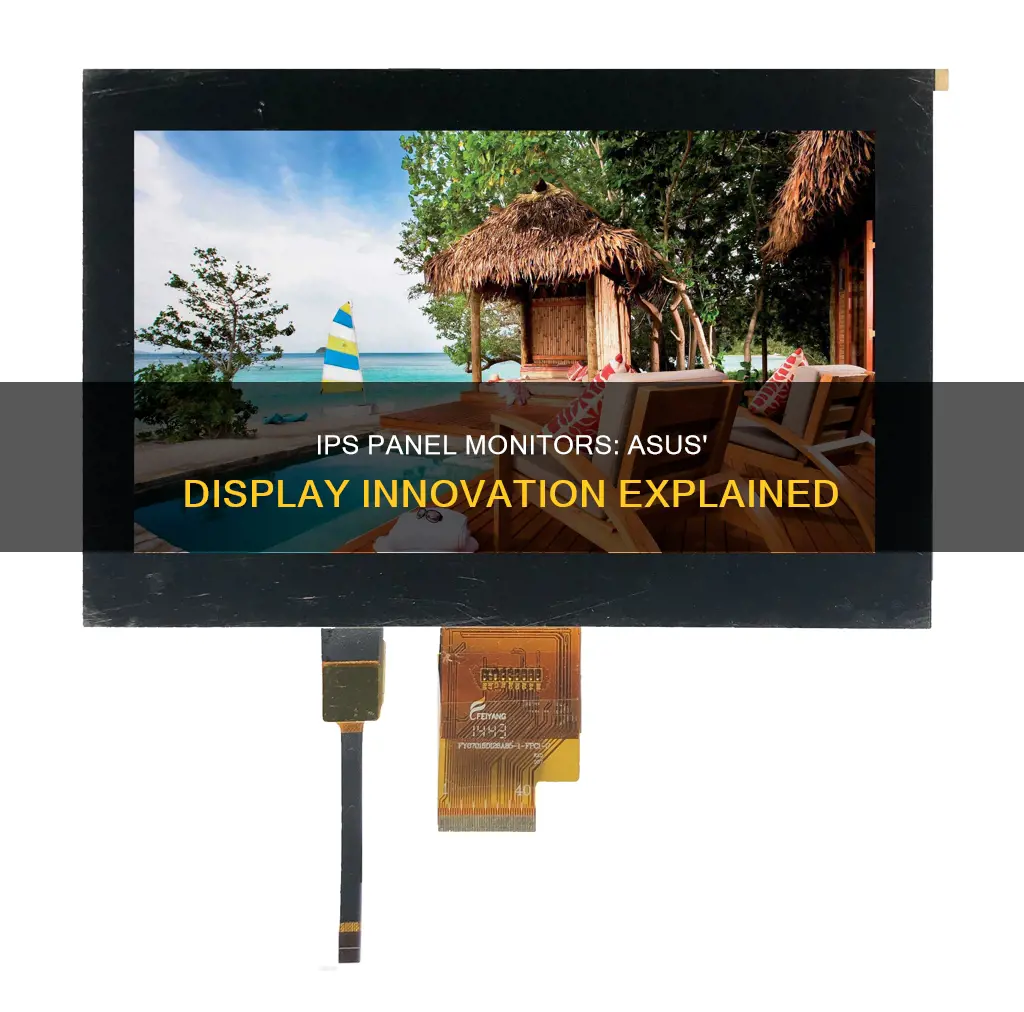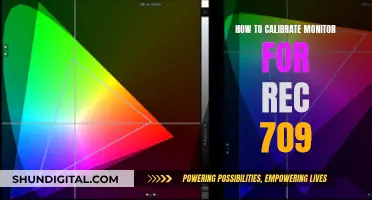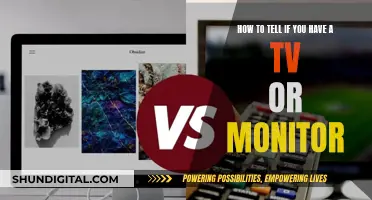
IPS stands for in-plane switching, a type of LED (a form of LCD) display panel technology. IPS panels are known for their superior colour accuracy and viewing angles compared to TN (twisted nematic) and VA (vertical alignment) panels. They are also more expensive. IPS panels are ideal for professional work, such as art and graphics, but less suited to gaming due to slower response times and higher input lag. However, improvements in manufacturing have led to faster response times and lower input lag, making IPS panels a viable option for gaming monitors.
| Characteristics | Values |
|---|---|
| Display Technology | In-plane switching (IPS) |
| Display Type | LED (a form of LCD) |
| Image Quality | Great |
| Use Case | Professional work (art, graphics, etc.) |
| Colors | Accurate, vivid, rich |
| Viewing Angles | Wide, ultra-wide, super-wide, maximum available |
| Response Time | Sufficient, improved, slower than TN panels |
| Refresh Rate | High enough for gaming |
| Resolution | 1080p, 1440p, 4K |
| Brightness | 300 nits, 320 nits, 350 nits, 380 nits, 400 nits, 1000 nits |
| Price | Expensive, very expensive |
What You'll Learn

IPS vs TN and VA panels
IPS, TN, and VA are the three main types of LCD panels used in monitors. Each has its own advantages and disadvantages, catering to different user needs.
IPS Panels
IPS stands for In-Plane Switching. IPS panels are known for their superior colour accuracy and wide viewing angles, making them ideal for professional work in graphics, photography, and video editing. They offer a higher bit depth, covering 95-100% of DCI-P3, which is perfect for digital cinema. Additionally, IPS panels can maintain good picture quality at viewing angles of up to 178 degrees.
However, IPS panels typically have slower response times compared to TN panels, averaging around 4ms. They also suffer from backlight bleeding and IPS glow, which can be an issue for users working in dark environments.
TN Panels
TN stands for Twisted Nematic. TN panels are the oldest and most widely produced type of LCD screens. They are characterised by their fast response times (as low as 1ms) and high refresh rates, making them the preferred choice for competitive gamers. TN panels are also more affordable than IPS and VA panels.
However, TN panels have limited viewing angles, typically 170 degrees horizontally and 160 degrees vertically. The image quality degrades when viewed from extreme angles, with colours appearing washed out. Additionally, TN panels have poor contrast ratios, typically in the range of 600:1 to 1200:1, and do not offer accurate colour reproduction, making them unsuitable for colour-critical work.
VA Panels
VA stands for Vertical Alignment. VA panels offer a balance between IPS and TN panels. They provide better picture quality than TN panels, with improved colour reproduction and wider viewing angles. VA panels also excel in contrast ratios, typically ranging from 2500:1 to 6000:1, resulting in deeper blacks and more vibrant colours.
However, VA panels have slower response times compared to TN and IPS panels, typically around 4-5ms. This slower response time can lead to motion blur and ghosting, making VA panels less ideal for competitive gaming.
In summary, IPS panels offer the best colour accuracy and viewing angles, making them ideal for professional work. TN panels have the fastest response times and highest refresh rates, catering to competitive gamers. VA panels strike a balance between IPS and TN panels, offering improved picture quality and contrast ratios. The choice of panel ultimately depends on the user's specific needs and preferences.
Folding Your ASUS Monitor Stand: A Step-by-Step Guide
You may want to see also

IPS panel pros and cons
IPS panels, or In-Plane Switching panels, are a type of LCD (Liquid Crystal Display) that address the limitations of TN (Twisted Nematic) panels, such as limited viewing angles and poor colour accuracy. They are commonly used in devices like phones, tablets, laptops, monitors, and televisions. Here are the pros and cons of IPS panels:
Pros:
- Wide Viewing Angle: IPS panels offer a much wider viewing angle compared to TN panels, making them ideal for collaborative work or when the device is used in various positions.
- No Touch-Based Distortion: Unlike TN displays, IPS panels are not susceptible to touch-based distortion. This means that touching the screen will not cause any temporary visual distortion or colour changes around the touched area.
- Excellent Colour Reproduction: IPS panels were designed to address the poor colour reproduction of TN displays. They offer superior colour accuracy, a broader colour spectrum, and vibrant, true-to-life colours. This makes them ideal for colour-critical applications like graphic design, photography, and video editing.
- Better Sunlight Visibility: IPS panels have superior sunlight visibility and can maintain clear visibility and readability even under bright lighting conditions. This is due to their high-quality backlighting and superior colour reproduction capabilities.
- Longevity: IPS displays are known for their longevity, often lasting for 10 to 20 years. They also have a longer lifespan than TN panels, making them a better long-term investment for certain users.
Cons:
- Increased Power Consumption: IPS panels consume more power than TN panels, typically around 15% more. This higher power consumption can impact the battery life of portable devices.
- Slow Response Time: IPS panels have slower response times than TN panels, which can result in motion blur and lagging during fast-paced activities like gaming. This makes TN panels a more popular choice among gamers.
- Higher Cost: IPS panels are generally more expensive than TN panels due to their superior image quality. This higher cost may be a factor for budget-conscious consumers.
- Thickness and Fingerprint Sensor Limitations: IPS panels require a backlight behind the liquid crystal layer, adding to their thickness. Additionally, IPS displays are currently not well-suited for optical on-screen fingerprint sensors due to their inherent backlighting and structural constraints.
- Limited Contrast Ratio: While IPS panels have an improved contrast ratio over TN panels, they fall short when compared to VA (Vertical Alignment) displays, which can produce deeper blacks and brighter whites.
In summary, IPS panels offer superior colour accuracy, wide viewing angles, and excellent colour reproduction, making them ideal for professionals in fields like graphic design and photography. However, they have slower response times and consume more power, making TN panels a preferred choice for certain users, especially gamers.
VA's CPAP Monitoring: How It Works and Why
You may want to see also

IPS panel history
IPS, or In-Plane Switching, is a type of monitor display and screen technology. More specifically, an IPS panel is a type of TFT LCD (Thin-Film Transistor Liquid Crystal Display). IPS panels are known for their superior colour reproduction and viewing angles compared to TN (Twisted Nematic) panels.
The active-matrix IPS TFT LCD was developed by Hitachi in 1996 as a solution to the display limitations of TN TFT LCDs, which were the standard non-IPS LCDs at the time. TN panels suffered from poor viewing angles, inverting colours at extreme angles, and low-quality colour reproduction. IPS panels were designed to address these flaws by altering the pixels to be parallel, rather than perpendicular, to the panels. This results in a wider viewing angle and higher-quality colour reproduction.
IPS panels are now widely used in high-performance tablets and smartphones, as well as computer and laptop monitors. They are particularly popular among creative professionals due to their superior colour accuracy and viewing angles.
Over time, IPS technology has continued to evolve and improve, with various manufacturers developing their own versions, including:
- Super-IPS (S-IPS)
- Advanced Super-IPS (AS-IPS)
- Enhanced IPS (E-IPS)
- Horizontal IPS (H-IPS)
- Professional IPS (P-IPS)
- Advanced High-Performance IPS (AH-IPS)
Monitoring Employee Internet Usage: Free, Easy, and Effective Ways
You may want to see also

IPS panel manufacturing
IPS stands for in-plane switching, a type of LED (a form of LCD) display panel technology. IPS panels are characterised by their superior colour accuracy and viewing angles compared to other main types of display panels, TN (twisted nematic) and VA (vertical alignment).
IPS panels are used in everything from televisions, computer monitors, and wearable devices. They are particularly popular for professional work, such as art and graphics, due to their image quality.
IPS panels are defined by the shifting patterns of their liquid crystals. These crystals are aligned in parallel to produce rich colours. The liquid crystal's ability to shift horizontally creates better viewing angles.
IPS panels were designed to overcome the limitations of TN panels, which often displayed colour distortion and fading when viewed from wide angles. IPS panels can display over 16 million colours and do not lighten or show tailing when touched, making them ideal for touch-screen devices.
IPS panels have advanced over time, with newer iterations improving response times, contrast ratios, and colour accuracy. However, they are more expensive to produce than TN panels and require more power.
IPS panels are created by sandwiching a layer of liquid crystals between two glass surfaces. The liquid crystal molecules are aligned parallel to these surfaces and reoriented by an applied electric field, allowing light to pass through them easily.
Asus Monitor Model: A Quick Identification Guide
You may want to see also

IPS panel alternatives
IPS panels are a type of LED display panel technology, and stand for in-plane switching. They are known for having the best colour and viewing angles compared to TN (twisted nematic) and VA (vertical alignment) panels. However, they are also the most expensive of the three.
IPS panels are great for professional work, such as art and graphic design, but they are less commonly used for gaming monitors due to their slower response times and higher cost.
TN Panels
TN panels are the oldest LCD panel type and are the preferred choice for competitive gamers due to their rapid response time and the fastest refresh rates on the market. They are also the least expensive panel technology, making them ideal for cost-conscious consumers. However, they have the worst colour reproduction and the narrowest viewing angles, which can cause issues when used for colour-critical work.
VA Panels
VA panels were developed to improve upon the drawbacks of TN panels. They offer higher contrast ratios, better colour reproduction, and wider viewing angles than TN panels. They are ideal for watching movies and for games focused on rich imagery. However, they have slower response times than TN panels, making them less suitable for competitive gaming.
OLED Panels
OLED panels differ from IPS, TN, and VA panels as they don't use a backlight. Instead, they use positively/negatively charged ions to light up each pixel individually. This allows for true blacks and eliminates screen glow. OLED panels also offer instantaneous response times and don't suffer from backlight bleeding or blooming. However, they are susceptible to permanent image burn-in and are usually pricier than other panel technologies.
Internet Surveillance: Schools' Monitoring of Students' Online Activity
You may want to see also
Frequently asked questions
IPS stands for in-plane switching, a type of LED display panel technology. IPS panels are known for having the best colour and viewing angles among the other main types of display panels, TN (twisted nematic) and VA (vertical alignment). IPS panels are also the most expensive of the three.
IPS panels offer consistent, accurate colour from all viewing angles. They also have the best viewing angles and colour of the three main types of display panels. However, IPS panels are more expensive to produce than TN panels and have slower response times. They also require up to 15% more power than TN panels.
The ASUS ROG Strix OLED XG27AQDMG is a 27-inch monitor with a 1440p screen, a 240Hz refresh rate, and very low input lag. The ASUS ROG Swift OLED PG34WCDM is another option if you're looking for an ultrawide monitor with a 240Hz refresh rate and a 1440p display.







